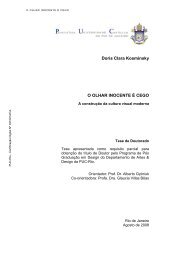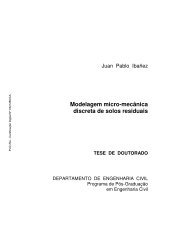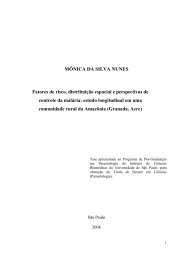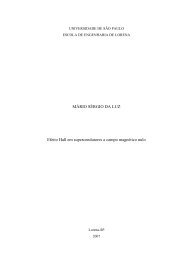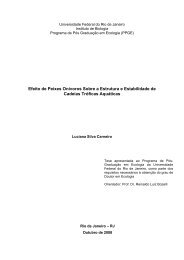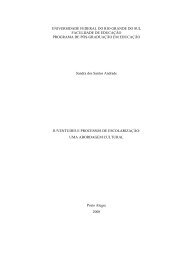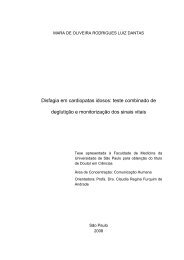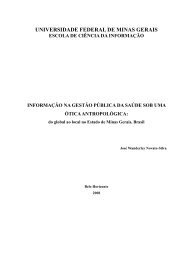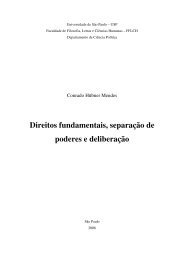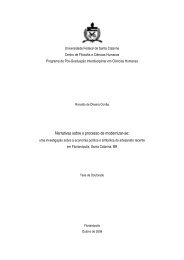You also want an ePaper? Increase the reach of your titles
YUMPU automatically turns print PDFs into web optimized ePapers that Google loves.
466 R.S. Car<strong>do</strong>so et al. / Molecular Immunology 43 (2006) 464–47294 ◦ C, 2.5 min at 54 ◦ C and 1.5 min at 70 ◦ C, with a 7-minextension period).In order to make this PCR a semiquantitative method, weincluded in the mix an internal amplification control of the-actin <strong>gene</strong> (-actin forward ATGGATGACGATATCGCTand -actin reverse ATGAGGTAGTCTGTCA). The adequatenumber of PCR cycles to reach the log-phase amplificationwas determined in experiments with 25, 30 and 35PCR cycles. The signal <strong>gene</strong>rated by the 30-cycle PCR wassignificantly lower than that <strong>gene</strong>rated by the 35-cycle PCR.This result demonstrates that at 30-cycle PCR, the amplificationof the TRBV8.1-BD2.1 rearranged segment (and thebeta-actin segment) was at log-phase and was a<strong>do</strong>pted in thisstudy (data not shown).After cycling, 15 l of PCR products were resolved by1.8% agarose gel electrophoresis and transferred (blotting)to a nylon Hybond N+ membrane (Amersham Biosciences).The PCR products were identified by hybridization with 7–15million cpm of each T-cell receptor beta (TRBV8.1) and -actin 32 P radiolabeled probe.Imaging plates and a phosphor imager apparatus (Cyclonemodel, Packard Instruments, USA) were used to capturethe hybridization signals and the OptiQuant ® software(Packard) was used to quantify the signals with local backgroundsubtraction. The adequate level of image saturationwas ensured by serial dilution of the positive control (data notshown).For the data from V(D)J recombination experiments weapplied t-test as statistical method of analysis and a P-value < 0.05 was considered to be significant from three independentdeterminations.2.3. cDNA microarray methodWe used a set of six microarrays containing a total of 9216cDNA sequences in the form of PCR products, spotted induplicate on 2.5 cm × 7.5 cm Hybond N+ nylon membranes(Amersham Biosciences). The arrays were prepared in ourlaboratory using a Generation III Array Spotter (AmershamBiosciences—Molecular Dynamics, USA).Mouse thymus expressed sequence tag (EST) cDNAclones were obtained from the Soares thymus 2NbMTnormalized library, prepared from a C57Bl/6J 4-week-oldmale thymus, and available from the I.M.A.G.E. Consortium(http://image.llnl.gov/image/html/iresources.shtml) andfrom the RZPD Deutsches Ressourcenzentrum für GenomforschungGmbH (www.rzpd.de).The cDNA inserts were homo<strong>gene</strong>ous in size (near 1 kb)and cloned in three vectors (pT7T3D, pBluescript andLafmid) and were amplified on 384- or 96-well plates usingvector-PCR amplification with the following primers,which recognize the three vectors: LBP 1S GTGGAATTGT-GAGCGGATACC forward and LBP 1AS GCAAGGCGAT-TAAGTTGG reverse.The membranes were first hybridized with the LBP 1AS[- 33 P]dCTP-labeled oligonucleotide (vector hybridization).Quantification of the obtained signals allowed the estimationof the amount of cDNA insert deposited in each spot. Afterstripping, the membranes were used for hybridization withcDNA complex probes (sample hybridization).The characterization of each cDNA sequence was updatedusing the Eloge ® (Ipsogen, France, www.ipsogen.fr)software, which runs on our local server and links eachclone ID with the genome data banks GenBank (www.ncbi.nlm.nih.gov) and S.O.U.R.C.E. (http://genome-www5.stanford.edu/cgi-bin/source/sourceSearch), providing informationsuch as DNA and protein sequences, biological andmolecular functions and chromosomal location.2.4. Complex cDNA probe preparation andhybridizationIn this study, we refer to the radioactive cDNA originatingfrom the thymus RNA samples (FTOCs) as complex probeand to the PCR product originating from the clones and deposite<strong>do</strong>n nylon microarrays as target.The 33 P-labeled cDNA complex probes were preparedby reverse transcription of 10 g of thymus total RNA usingoligo dT 12–18 as primer. One-hundred l 33 P-cDNAcomplex probe containing 30–50 million cpm was hybridizedwith nylon microarrays as previously described(Nguyen et al., 1995; Bertucci et al., 2002; Verdeil et al.,2002).2.5. cDNA microarray image acquisitionWe used imaging plates and a phosphor imager apparatus(Packard model Cyclone) to capture the hybridization signalsand the BZScan software (available from the authors athttp://www.tagc.univ-mrs.fr) to quantify the signals with localbackground subtraction, whose spots were matched witha template grid.The ratio between vector probe hybridization values andcomplex probe hybridization values for each spot was usedas reference normalization value. We also employed totalintensity normalization using the median expression value(Quackenbush, 2002).2.6. Hierarchical clusteringWe used a hierarchical clustering algorithm, comparingmeans of different <strong>gene</strong>s whose standard deviation did notoverlap, and whose objective was to compute a dendrogramthat assembles all elements into a single tree. The softwarefor this algorithm can be obtained from the authors(Eisen et al., 1998) at(http://rana.stanford.edu/clustering).Before clustering, the <strong>gene</strong> expression values were mediancenteredand log transformed using the Pearson correlationdistance metrics and average linkage for clustering organizationfrom six independent determinations of each situationstudied.



